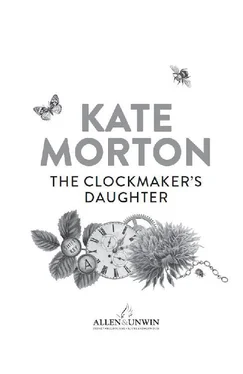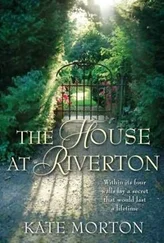Kate Morton - The Clockmaker's Daughter
Здесь есть возможность читать онлайн «Kate Morton - The Clockmaker's Daughter» весь текст электронной книги совершенно бесплатно (целиком полную версию без сокращений). В некоторых случаях можно слушать аудио, скачать через торрент в формате fb2 и присутствует краткое содержание. Год выпуска: 2018, Издательство: Allen & Unwin, Жанр: Старинная литература, на английском языке. Описание произведения, (предисловие) а так же отзывы посетителей доступны на портале библиотеки ЛибКат.
- Название:The Clockmaker's Daughter
- Автор:
- Издательство:Allen & Unwin
- Жанр:
- Год:2018
- ISBN:нет данных
- Рейтинг книги:4 / 5. Голосов: 1
-
Избранное:Добавить в избранное
- Отзывы:
-
Ваша оценка:
- 80
- 1
- 2
- 3
- 4
- 5
The Clockmaker's Daughter: краткое содержание, описание и аннотация
Предлагаем к чтению аннотацию, описание, краткое содержание или предисловие (зависит от того, что написал сам автор книги «The Clockmaker's Daughter»). Если вы не нашли необходимую информацию о книге — напишите в комментариях, мы постараемся отыскать её.
The Clockmaker's Daughter — читать онлайн бесплатно полную книгу (весь текст) целиком
Ниже представлен текст книги, разбитый по страницам. Система сохранения места последней прочитанной страницы, позволяет с удобством читать онлайн бесплатно книгу «The Clockmaker's Daughter», без необходимости каждый раз заново искать на чём Вы остановились. Поставьте закладку, и сможете в любой момент перейти на страницу, на которой закончили чтение.
Интервал:
Закладка:
Not like the turbulent aftermath of her mother’s death, the high emotion and public grieving, the newspaper columns that ran alluring black-and-white photographs of Lauren Adler and used words like ‘tragedy’ and ‘sparkling’ and ‘fallen star’.
Perhaps Frances Brown had also been a sparkling person?
A thought occurred to Elodie. The document holder that had once belonged to James Stratton was still inside the satchel and now she took the framed photograph from inside.
Was this Frances Brown? The age was about right, for this face could not belong to a person much older than twenty.
Elodie stared closely, captured by the young woman’s gaze, her direct expression. Self-possession, that’s what it was. This was someone who knew her own mind, her own worth. The sort of woman about whom a passionate young artist might write: … if I cannot have her I shall surely go mad …
She typed ‘Frances Brown’ into Google and an image search brought up multiple copies of the same portrait: a young woman in a green dress, also beautiful but predictably so – not the person whose likeness had been captured by the photograph.
Elodie felt a dull wash of disappointment. The feeling was not unfamiliar. It was the archivist’s lot, for they were treasure hunters, in a way, sifting through the everyday detritus of their subject’s life, sorting it methodically, constructing records, always hoping for that rare precious find.
It had been a long shot: the sketchbook and note had been found in the same satchel as the document holder containing the photograph, but there was no apparent connection beyond that. The satchel and sketchbook had belonged to Edward Radcliffe, the document holder to James Stratton. At this point, there was no evidence that the two men had even been acquainted.
Elodie took up the photograph once more. The frame itself was of a high quality: sterling silver, intricately patterned. James Stratton’s document holder was dated 1861 and it seemed reasonable to assume that the photograph inside it had belonged to him and that it had been acquired after that time. Also, that the woman in it had meant enough for him to keep it. But who was she? A secret romance? Elodie couldn’t think that she had ever come across any of the telltale references in his journals or letters.
She looked again at the beautiful face, searching it for clues. The longer she stared at the image, the stronger the pull it exerted. The photograph was over a hundred years old, more likely a hundred and fifty, and yet the woman in it was unmarked by time; her face was strangely contemporary, as if she might have been one of those girls outside now on the summery streets of London, laughing with her friends and enjoying the sun’s warmth on her bare skin. She was confident and amused, staring at the photographer with a familiarity that was almost uncomfortable to perceive. As if Elodie were trespassing on a private moment.
‘Who are you?’ she said beneath her breath. ‘And who were you to him?’
There was something more, something difficult to articulate. The woman in the photograph was illuminated : it was that face, of course, with its beautiful features and the enlivened expression, but it was the styling of the image, too. The long, unfussy hair, the romantic dress, loose and earthy, but also alluring where it caught her waist, where a sleeve had been pushed up her arm to reveal sunlit skin. Elodie could almost feel the warm breeze coming off the river to brush against the woman’s face, to lift her hair and heat the white cotton of her dress. And yet, that was her mind playing tricks, for there was no river in the picture. It was the freedom of the photograph she was responding to, its atmosphere. Now, that was the sort of dress Elodie would like to wear at her wedding—
Her wedding!
Elodie glanced at the clock and saw that it was already quarter past ten. She hadn’t even responded to Pippa’s message, but she was going to have to get moving if she expected to be at King’s Cross by eleven. Gathering her phone and notebook, her diary and sunglasses, Elodie loaded her bag. She surveyed the desktop for anything she might have forgotten and, on a whim, picked up the framed photograph, the woman in that wonderful dress. With a glance at where Margot was hunched over by the filing cabinet, she wrapped it in the tea towel and tucked it in her bag.
Making her way through the office door and up the stairs into the warm summer’s day, Elodie started texting her reply.
11 is fine , she typed; Leaving now – send me the address and I’ll see you soon.
CHAPTER FOUR
Pippa was working that day at a publishing house on New Wharf Road, putting together an installation in the foyer. When Elodie arrived at quarter past eleven, her friend was perched at the top of a very tall ladder in the centre of the contemporary white room. She’d been stringing long dresses and other antique items of clothing – skirts and bloomers and corsets – from the high ceiling and the effect was enchanting, as if a dance floor of ivory ghosts had swept in on the breeze. Words came to Elodie’s mind from one of her favourite Wilde poems:
We caught the tread of dancing feet,
We loitered down the moonlit street,
And stopped beneath the harlot’s house …
We watched the ghostly dancers spin,
To sound of horn and violin,
Like black leaves wheeling in the wind …
Pippa spotted Elodie and exclaimed around the wooden ruler clenched horizontal in her teeth.
Elodie waved back and held her breath while her friend leaned to fasten a petticoat strap to a thread of fishing line.
After an excruciating moment, Pippa made it back to the ground in one piece. ‘Won’t be long,’ she said to the man behind the desk as she shrugged on her backpack. ‘Just out for a coffee.’
As they pushed through the large glass door, Elodie fell into step beside her friend. Pippa was wearing dark wartime dungarees and the sort of puffed-up sneakers favoured by the teenage boys who gathered at the fish and chip shop on Friday evenings. The items were not individually notable, but somehow on Pippa their effect was magnified so that Elodie felt like a dreary little minnow in her jeans and ballet flats.
Pippa drew on her cigarette as they cut through a tall locked gate (to which she somehow had the code) and skirted the canal. ‘Thanks for coming early,’ she said on an exhalation. ‘I’m going to have to work through lunch to get it finished. The author’s coming in tonight to launch the book. Have I shown you? It’s gorgeous – an American who found out that the English aunt she’d known only as an ancient woman in a home had once been mistress to the king and had collected the most extraordinary wardrobe of dresses, all in mothballs in a storage unit in New Jersey. Can you imagine? The only thing my aunt left me was a nose I could steer a boat with.’ They crossed the street and made their way over the bridge towards a glass-faced restaurant adjacent to the Tube station.
Inside, a friendly waitress seated them at a round table in the back corner. ‘Macchiato?’ she said, to which Pippa replied, ‘Perfect. And a … ?’
‘Flat white, please,’ said Elodie.
Pippa wasted no time in pulling a bulging scrapbook from her bag, letting it fall open to reveal all manner of loose papers and samples. ‘Here’s what I’m thinking,’ she began, before launching into an enthusiastic description of sleeves and skirts, the pros and cons of peplums, the benefits of natural fabrics, switching from one illustration to another, barely pausing for breath, until the table was covered in magazine pages, fabric swatches and fashion sketches. Finally, she said, ‘So, what do you think?’
Читать дальшеИнтервал:
Закладка:
Похожие книги на «The Clockmaker's Daughter»
Представляем Вашему вниманию похожие книги на «The Clockmaker's Daughter» списком для выбора. Мы отобрали схожую по названию и смыслу литературу в надежде предоставить читателям больше вариантов отыскать новые, интересные, ещё непрочитанные произведения.
Обсуждение, отзывы о книге «The Clockmaker's Daughter» и просто собственные мнения читателей. Оставьте ваши комментарии, напишите, что Вы думаете о произведении, его смысле или главных героях. Укажите что конкретно понравилось, а что нет, и почему Вы так считаете.












